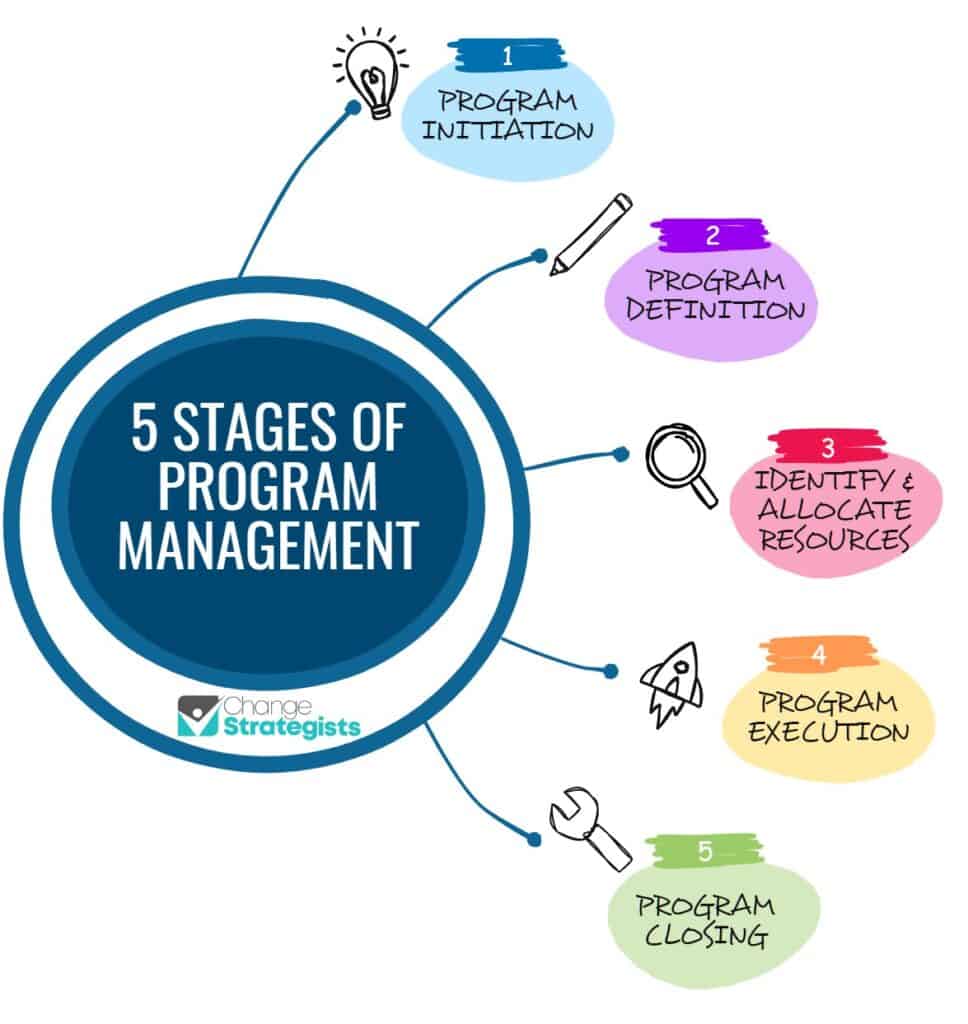Organizations generally group tasks into projects, with each project assigned a manager to oversee the execution. As the company grows more projects are required, so what happens when multiple projects need to be run at the same time? This is where program management steps in.
Program management is the collective coordination of individual projects into portfolios called programs. Program management is a business transformation strategy under project management with different program examples like visionary, mandatory and emerging programs. They are different for every organization, depending on the projects they have.
Most people think of computer science and programming when faced with the term “programs” or “program management”, but in business the terms relate to business transformation and strategic management. Let’s get started!
What Is Program Management, and Why Is It Important?
Program management is a business strategy for accomplishing organizational goals by grouping related tasks as projects into portfolios. In a nutshell, it is the coordination and organization of company programs.
A program in this context is a group of related tasks or activities called projects that are coordinated and managed in a similar style for productive output. Programs are pretty different from projects in their manner of execution and delivery. While programs deal with the general company output, projects deal with specific company targets.
A program manager is responsible for coordinating program management for any organization, while a project manager is in charge of project management.
Even though most people confuse program and project management, they are entirely different management strategies with specific organizational benefits.
An effective program manager brings together all the necessary resources – people, finances, equipment, and materials – to get the job done on time and within budget. They also work closely with stakeholders to ensure that everyone is aware of the project’s goals and objectives.
Why Program Management Is an Essential Management Strategy
Organizing and coordinating several projects can be challenging because of the generalized approach to organizational procedure. Therefore, a higher-level manager’s specialized skills and dedication are critical to overseeing the scale and complexity associated with managing separate projects.
Program management is essential for organizing complex tasks to create an effective strategy, without which the components of the organization, including members, will fail.
Here is why program management is vital in organizational strategy.
For Effectively Managing Project Overlap
Usually, it is pretty normal to discover project overlap when attending to projects within an organization. That is to say that several projects depend on one another. As a result, failure to complete one ultimately affects the completion of the other in the series.
Eventually, a vicious cycle exists where projects remain uncompleted, leading to the eventual failure of the organization. Program management allows the company to group interrelated or interdependent projects to facilitate their execution.
Furthermore, Program management enables the leadership of an organization to track the connection between projects to create an effective strategy for the company.
To Make Projects More Adaptable by Increasing Flexibility.
Projects within an establishment require human resources for execution, and this is where team building comes in handy. However, members of an organization can only give their best toward completing tasks when they experience flexibility in handling projects.
As a result, it is pretty dangerous to implement rigid operational procedures as it can stifle the flourishing of a productive team at work. Therefore, program management allows the company to set up adaptable units to carry out tasks or projects through effective people management.
For instance, the program manager assists the project manager with creating strategies that they can use to keep teammates focused on the task at hand.
For Better Management of Organizational Resources
Both program and project management are effective for managing company resources. Essentially, a company or organization can only thrive as much as its resources are appropriately addressed. It leads to a better return on investment, profitability, and company goals.
However, program management allows the organization to manage its resources by proper allocation for project execution. The strategy for resource management is pretty different when you implement project management. Essentially, project management allows the direct coordination and distribution of resources among projects or tasks.
Now that you know what program management is and its relevance, it is time to consider its operational procedure in detail by discussing the lifecycle of program management. The program management life cycle explains how program management works to actualize long-term organizational goals.
Stages in Program Management: How Does the Program Management Process Work?
Unlike project management, which contains an end point, program management is continuous and, in most cases, requires a permanent role to be created. As a result, it is essential to understand the life cycle of program management and why it lasts that long.
Program Management Stages or Lifecycle

Program management as an organizational strategy has five critical stages, which are:
- Program Initiation
- Program definition
- Identification and allocation of resources
- Program execution
- Closing
Stage One: Program Initiation
The first stage serves as the initial point of the program lifecycle. This stage involves a meeting with the organization’s leadership and program manager to identify their general goals for the company.
They shift through previous plans, comparing them to the present goals and seeking ways to merge related targets. It is a critical stage in the process because it defines the overall strategy for project execution, including stakeholder involvement, member motivation and productivity.
Stage Two: Program Definition
Stage two involves a total spelling out of the terms surrounding the programs in line with the organization’s highest goals. It also creates an opportunity for stakeholders within the organization and those connected with the program and associated projects to voice out their contributions and concerns as it affects them in their separate units.
The idea is to create a forum to amend the organizational terms, including documents before ratification. Program definition is similar to a control measure that the management implements before embarking full scale on a program/project to avoid any obstacles.
After all deliberations, the program definition gives rise to a document that guides project managers and their team members to stay on track and complete their projects.
Stage Three: Identification and Allocation of Resources
Every organization has a resource pool from which the organization finances and facilitates the attainment of its goals. The resource pool usually contains all finances, infrastructure and raw materials (if they are into manufacturing) to help them succeed. It also includes an in-house assignment of tasks and assignments.
As a result, program managers, project managers, team members and all other relevant personnel and human resources are given their specific functions.
Sometimes, this stage can also involve onboarding, recruitment, or hiring new team members or employees to contribute their skills toward attaining company goals.
Stage Four: Program Execution
The penultimate stage is usually the longest in the life cycle of program management. The same goes for project management with slight variations.
This fourth stage in program management involves the actual program execution after deliberations.
Essentially, the programs (project portfolios) are the lifeblood of the program management process. As a result, failure to effectively run the programs means the ultimate failure of the organization’s goals and objectives. A failed program can cause an enterprise to lose its competitive advantage in the market.
Stage Five: Closing or Closure
The closing stage is the fifth and final stage in the program management process. It marks the end of the life cycle of a successful program and probably the beginning of a new one. Companies reach the closing of their program management prices when all programs and associated projects have been completed.
In most cases, the closing causes the organization to break up the existing team to set up a new one to start the program management process afresh.
Alternatively, some organizations may mark the closing with a little celebration and special employee compensation like raises or bonuses before regrouping to restart the process.

Here is a table summarizing the lifecycle of program management.
| Stages in Program Management | Lifecycle Designation | Developmental Features and Characteristics |
| Stage one | Program Initiation | Definition of organizational goals Definition of stakeholder involvement Spot opportunities Set up a business case |
| Stage two | Program Definition | Opinion poll for organization members Amendment of program terms Program documentation Program definition. |
| Stage three | Identification and allocation of resources | Allocation of program resources Assigning of tasks Establishment of the process Infrastructural setup Milestone establishment |
| Stage four | Atual Program management | Monitor and track program progress Implement program risk management Ensure adherence to plan Audit deliverables |
| Stage five | Closing | Turn in program deliverables Program review Member compensation Regrouping/restarting Performance appraisal and quality assessment. |
What Are Programs in Project Management?
Programs in project management are a collection of tasks or projects that are managed as a group. It is a management tool organizations use to create efficiency of scale.
Believe it or not, project management was once considered the most effective approach for strategic organizational management.
However, it can be challenging to monitor the execution of each project separately. As a result, program management was created to enable organizations to better allocate responsibility by putting a manager in charge of overseeing the general running and execution of organizational goals.
A program manager is someone responsible for managing programs by coordinating all projects in a program portfolio. In addition, the program manager aligns all programs to suit the organization’s long-term goals. As a result, programs are not like projects which are short-term deliverables.
Instead, they are ongoing and possibly permanent engagements. Programs exist in strategic management to counter the difficulties of managing individual tasks through collective management.
What Are the Essential Features of a Program?
Not all collective assignments are programs in project management. Specific criteria are vital for creating programs. Here are the main features of programs in strategic management.
- All programs are large-scale deliverables: Programs deal with the company goals and objectives. They usually highlight and reflect the mission statement of the organization. As a result, tasks with smaller or short-term targets are not programs.
- All programs require a general approach: Since programs take a broad approach to execution, they do not deal with the specific details that make up a project.
- All programs are strategic: While projects deal with the process and result of tasks in an organization, programs deal with the strategy for executing smaller projects. As a result, all programs have multiple layers of plans to guarantee their smooth execution.
What Are Program Examples in Project Management?
Program examples in project management also refer to the various forms programs can take in strategic management. Also, programs benefit the enterprise by encouraging clarity, project efficiency and better risk management. As a result, program examples can be visionary, mandatory or emerging.
Visionary Programs
Use visionary programs to incorporate the general picture of the company’s goals and objectives. It is the big picture representation of what the organization’s leadership has in mind. One major characteristic of visionary programs is that they are usually ambiguous and somewhat difficult to execute as they can sometimes be idealistic.
Therefore, they require in-depth analysis to break them into their component projects. For example, a vision to create an eco-friendly business is visionary because it does not highlight how the company wants to become eco-friendly.
Program management is the strategy that breaks the vision of an eco-friendly business into smaller bits, like deciding to go paperless or starting another company branch that will be full-scale eco-friendly. Furthermore, visionary programs can sometimes be tentative, involving mostly fresh ideas.
Mandatory Programs
Very different to visionary programs, mandatory programs are not freshly thought ideas but instead an improvement on existing protocols like updating business terms and conditions, privacy policies, compliance with specific government policies, etc.
Essentially, mandatory programs involve the implementation of new approaches within the company. The idea behind mandatory programs is to remain in business and improve the organization’s competitive advantage.
Mandatory programs are easy to execute, more exciting and keep team members more engaged because they have a lower barrier of entry.
Emerging Programs
Some projects start small and grow into bigger programs, in which case we have emerging programs.
Emerging programs are the most difficult to execute because they do not initially start as programs.
Instead, they are the product of complex or complicated projects that expand beyond the definition of a project.
Emerging programs are due to multiple projects that overlap, thus creating difficulty in allocating and managing resources for execution.
Frequently Asked Questions
What Is the Role of Program Management in Business Transformation?
Program management in business transformation oversees the fulfilment of larger organizational objectives like coordinating multiple projects without directly managing them. The company prioritizes strategic management and program implementation by controlling the main program through project delegation.
What Does a Program Mean for an Organization or Business?
A program for most businesses means a group of smaller organizational goals / tasks designed to meet significant set goals when executed. It is also a coordinated plan for multiple grouping projects with a mega end goal for the organization or business.
What Is the Difference Between Program and Project Management?
Program and project management differ in their execution and capacity. Program management focuses on the general company goals by grouping multiple projects into portfolios. In contrast, project management focuses on separate tasks as projects and handles them individually.
Final Thoughts
Now that you understand what program management is all about, the various stages and examples of programs under project management, we hope this piece serves as an excellent guide to assist you with the strategic management of your affairs!





